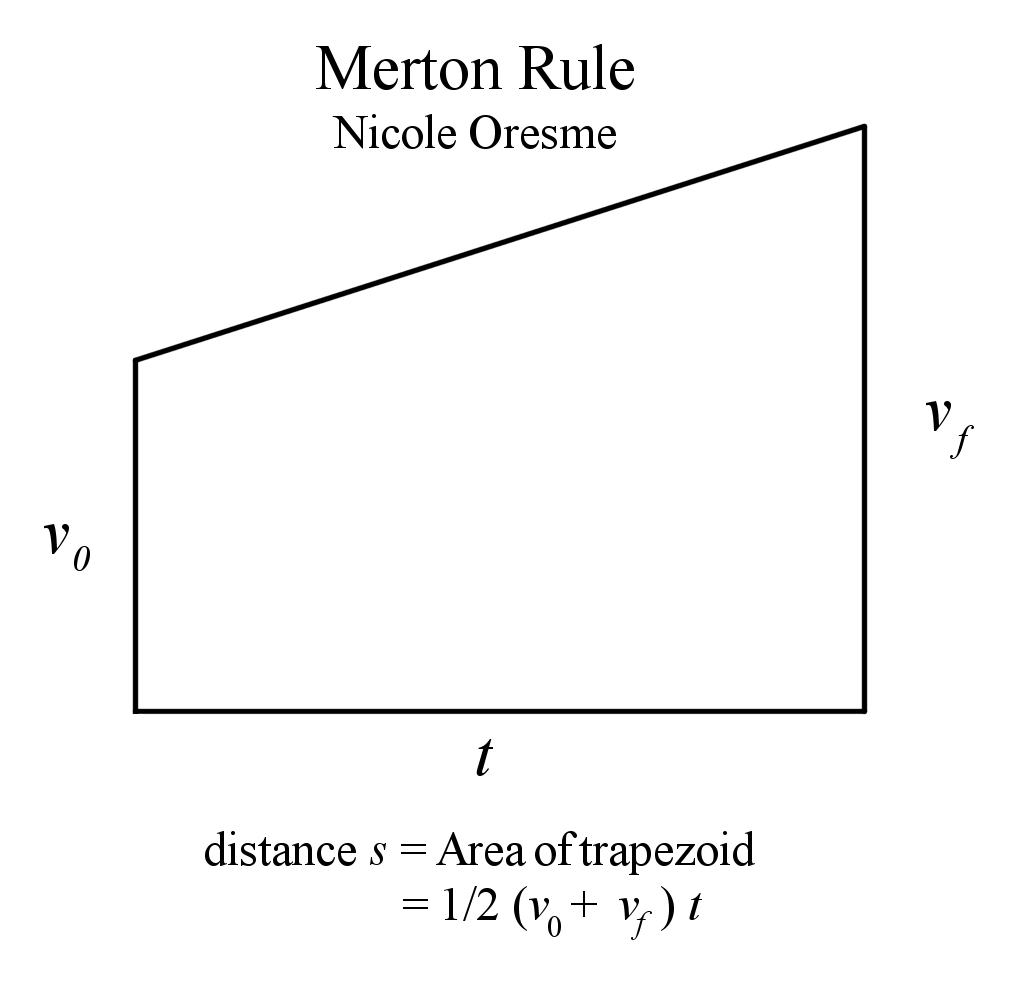mean speed theorem on:
[Wikipedia]
[Google]
[Amazon]

 The mean speed theorem, also known as the Merton rule of uniform acceleration, was discovered in the 14th century by the Oxford Calculators of
The mean speed theorem, also known as the Merton rule of uniform acceleration, was discovered in the 14th century by the Oxford Calculators of
William Heytesbury
, in ''The Stanford Encyclopedia of Philosophy''. Natural philosophy Merton College, Oxford History of the University of Oxford 14th century in science Classical mechanics

 The mean speed theorem, also known as the Merton rule of uniform acceleration, was discovered in the 14th century by the Oxford Calculators of
The mean speed theorem, also known as the Merton rule of uniform acceleration, was discovered in the 14th century by the Oxford Calculators of Merton College
Merton College (in full: The House or College of Scholars of Merton in the University of Oxford) is a constituent college of the University of Oxford in England. Its foundation can be traced back to the 1260s when Walter de Merton, chancellor ...
, and was proved by Nicole Oresme. It states that a uniformly accelerated body (starting from rest, i.e. zero initial velocity) travels the same distance as a body with uniform speed whose speed is half the final velocity of the accelerated body.
Details
Oresme provided a geometrical verification for the generalized Merton rule, which we would express today as (i.e., distance traveled is equal to one half of the sum of the initial and final velocities, multiplied by the elapsed time ), by finding the area of atrapezoid
In geometry, a trapezoid () in North American English, or trapezium () in British English, is a quadrilateral that has at least one pair of parallel sides.
The parallel sides are called the ''bases'' of the trapezoid. The other two sides are ...
. Clay tablets used in Babylonian astronomy
Babylonian astronomy was the study or recording of celestial objects during the early history of Mesopotamia. The numeral system used, sexagesimal, was based on 60, as opposed to ten in the modern decimal system. This system simplified the ca ...
(350–50 BC) present trapezoid procedures for computing Jupiter's position and motion
In physics, motion is when an object changes its position with respect to a reference point in a given time. Motion is mathematically described in terms of displacement, distance, velocity, acceleration, speed, and frame of reference to an o ...
.
The medieval scientists demonstrated this theorem—the foundation of " the law of falling bodies"—long before Galileo
Galileo di Vincenzo Bonaiuti de' Galilei (15 February 1564 – 8 January 1642), commonly referred to as Galileo Galilei ( , , ) or mononymously as Galileo, was an Italian astronomer, physicist and engineer, sometimes described as a poly ...
, who is generally credited with it. Oresme's proof is also the first known example of the modelization of a physical problem as a mathematical function with a graphical representation, as well as of an early form of integration. The mathematical physicist and historian of science Clifford Truesdell
Clifford Ambrose Truesdell III (February 18, 1919 – January 14, 2000) was an American mathematician, natural philosopher, and historian of science.
Life
Truesdell was born in Los Angeles, California. After high school, he spent two years in Eur ...
, wrote:Clifford Truesdell, ''Essays in The History of Mechanics'', (Springer-Verlag, New York, 1968), p. 30
The theorem is a special case of the more general kinematics equations for uniform acceleration.
See also
* Science in the Middle Ages *Scholasticism
Scholasticism was a medieval European philosophical movement or methodology that was the predominant education in Europe from about 1100 to 1700. It is known for employing logically precise analyses and reconciling classical philosophy and Ca ...
Notes
{{ReflistFurther reading
* Sylla, Edith (1982) "The Oxford Calculators", in Kretzmann, Kenny & Pinborg (edd.), ''The Cambridge History of Later Medieval Philosophy''. * Longeway, John (2003)William Heytesbury
, in ''The Stanford Encyclopedia of Philosophy''. Natural philosophy Merton College, Oxford History of the University of Oxford 14th century in science Classical mechanics